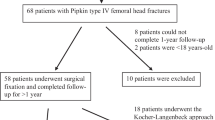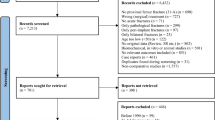Abstract
Purpose
The study aims to identify the optimal approach for femoral head fracture (FHF) by comparing the postoperative complications and outcome score of the Kocher–Langenbeck posterior approach (KLP) and trochanteric flip osteotomy (TFO) through a systematic review and meta-analysis.
Methods
MEDLINE, Embase and the Cochrane Library were systematically searched for studies published up to 22 January 2023, which compared TFO to the KLP for FHF treatment. The main outcomes of this meta-analysis were the rate of postoperative complications including osteonecrosis of the femoral head (ONFH), heterotopic ossification (HO), and total hip replacement (THR) conversion rate and Thompson–Epstein (T–E) score at the final follow-up.
Results
We included four studies with 57 cases of FHFs; 27 and 30 patients underwent TFO and the KLP, respectively. Following the pooled analysis, HO incidence was significantly higher in TFO than in the KLP (OR = 4.03; 95% CI 1.10–14.81; P = 0.04; I2 = 0%), but there were no differences in other variables, including the incidence of ONFH (OR = 0.41; 95% CI 0.07–2.35; P = 0.32; I2 = 0%), THR conversion rate (OR = 0.82; 95% CI 0.16–4.29; P = 0.81; I2 = 0%), and number of inferior results in the T–E score (OR = 0.49; 95% CI 0.14–1.73; P = 0.27; I2 = 0%).
Conclusions
Amongst the posterior approaches for FHFs, the KLP and TFO did not present significant clinical and radiological differences; hence, the approach can be selected depending on the surgeon’s experience and preference.





Similar content being viewed by others
Availability of Data and material
The data that support the findings of this study are available from the corresponding author, upon reasonable request.
References
Anderson, L. C., & Blake, D. J. (1994). The anatomy and biomechanics of the hip joint. Journal of Back and Musculoskeletal Rehabilitation, 4, 145–153.
Shaikh, A., Desai, M., Kantanavar, R., & Shah, K. (2021). Femoral head fracture without associated hip dislocation. Arthroplast Today, 8, 145–149.
Giordano, V., Giordano, M., Gloria, R. C., de Souza, F. S., di Tullio, P., Lages, M. M., et al. (2019). General principles for treatment of femoral head fractures. J Clin Orthop Trauma, 10, 155–160.
Peng, S. H., Wu, C. C., Yu, Y. H., Lee, P. C., Chou, Y. C., & Yeh, W. L. (2020). Surgical treatment of femoral head fractures. Biomed J, 43, 451–457.
Stannard, J. P., Harris, H. W., Volgas, D. A., & Alonso, J. E. (2000). Functional outcome of patients with femoral head fractures associated with hip dislocations. Clinical Orthopaedics and Related Research, 377, 44–56.
Droll, K. P., Broekhuyse, H., & O’Brien, P. (2007). Fracture of the femoral head. Journal of American Academy of Orthopaedic Surgeons, 15, 716–727.
Guo, J. J., Tang, N., Yang, H. L., Qin, L., & Leung, K. S. (2010). Impact of surgical approach on postoperative heterotopic ossification and avascular necrosis in femoral head fractures: A systematic review. International Orthopaedics, 34, 319–322.
Epstein, H. C., Wiss, D. A., & Cozen, L. (1985). Posterior fracture dislocation of the hip with fractures of the femoral head. Clinical Orthopaedics and Related Research, 201, 9–17.
Gardner, M. J., Suk, M., Pearle, A., Buly, R. L., Helfet, D. L., & Lorich, D. G. (2005). Surgical dislocation of the hip for fractures of the femoral head. Journal of Orthopaedic Trauma, 19, 334–342.
Mostafa, M. F., El-Adl, W., & El-Sayed, M. A. (2014). Operative treatment of displaced Pipkin type I and II femoral head fractures. Archives of Orthopaedic and Trauma Surgery, 134, 637–644.
Moher, D., Shamseer, L., Clarke, M., Ghersi, D., Liberati, A., Petticrew, M., et al. (2015). Preferred reporting items for systematic review and meta-analysis protocols (PRISMA-P) 2015 statement. Systematic Reviews, 4, 1.
Shea, B. J., Grimshaw, J. M., Wells, G. A., Boers, M., Andersson, N., Hamel, C., et al. (2007). Development of AMSTAR: A measurement tool to assess the methodological quality of systematic reviews. BMC Medical Research Methodology, 7, 10.
Kloen, P., Siebenrock, K. A., Raaymakers, E. L. F. B., Marti, R. K., & Ganz, R. (2002). Femoral head fractures revisited. Eur J Trauma, 28, 221–233.
Thompson, V. P., & Epstein, H. C. (1951). Traumatic dislocation of the hip: A survey of two hundred and four cases covering a period of twenty-one years. The Journal of Bone & Joint Surgery., 33, 746–778.
Slim, K., Nini, E., Forestier, D., Kwiatkowski, F., Panis, Y., & Chipponi, J. (2003). Methodological index for non-randomized studies (minors): Development and validation of a new instrument. ANZ Journal of Surgery, 73, 712–716.
Schmidt, F. L., Oh, I. S., & Hayes, T. L. (2009). Fixed- versus random-effects models in meta-analysis: Model properties and an empirical comparison of differences in results. British Journal of Mathematical and Statistical Psychology, 62, 97–128.
Higgins, J. P. T., Thomas, J., Chandler, J., Cumpston, M., Li, T., Page, M. J., et al. (2019). Cochrane Handbook for Systematic Reviews of Interventions (2nd ed., p. 10). Wiley.
Kokubo, Y., Uchida, K., Takeno, K., Yayama, T., Miyazaki, T., Negoro, K., et al. (2013). Dislocated intra-articular femoral head fracture associated with fracture-dislocation of the hip and acetabulum: Report of 12 cases and technical notes on surgical intervention. European Journal of Orthopaedic Surgery & Traumatology, 23, 557–564.
Zhang, H., Ge, J., Zhang, X., Ye, J., Shen, S., Zhuo, N., et al. (2020). Analysis of effectiveness of greater trochanteric osteotomy approach and K-L posterior approach in patients with type IV Pipkin fracture. Zhongguo xiu fu chong jian wai ke za zhi = Zhongguo xiufu chongjian waike zazhi = Chinese Journal of Reparative and Reconstructive Surgery, 34, 1258–1262.
Giannoudis, P. V., Kontakis, G., Christoforakis, Z., Akula, M., Tosounidis, T., & Koutras, C. (2009). Management, complications and clinical results of femoral head fractures. Injury, 40, 1245–1251.
Petek, D., Hannouche, D., & Suva, D. (2019). Osteonecrosis of the femoral head: Pathophysiology and current concepts of treatment. EFORT Open Rev, 4, 85–97.
Scolaro, J. A., Marecek, G., Firoozabadi, R., Krieg, J. C., & Routt, M. L. C. (2017). Management and radiographic outcomes of femoral head fractures. Journal of Orthopaedics and Traumatology, 18, 235–241.
Engel, J. L., Johnsen, P., Patel, N. K., Satpathy, J., & Mounasamy, V. (2021). Pipkin type IV femoral head fractures: A case series and review of literature. European Journal of Orthopaedic Surgery & Traumatology, 31, 791–795.
Wang, C. G., Li, Y. M., Zhang, H. F., Li, H., & Li, Z. J. (2016). Anterior approach versus posterior approach for Pipkin I and II femoral head fractures: A systemic review and meta-analysis. International Journal of Surgery, 27, 176–181.
Swiontkowski, M. F., Thorpe, M., Seiler, J. G., & Hansen, S. T. (1992). Operative management of displaced femoral head fractures: Case-matched comparison of anterior versus posterior approaches for Pipkin I and Pipkin II fractures. Journal of Orthopaedic Trauma, 6, 437–442.
Tosounidis, T. H., Giannoudis, V. P., Kanakaris, N. K., & Giannoudis, P. V. (2018). The Kocher-Langenbeck approach: State of the Art. JBJS Essent Surg Tech, 8, e18.
Fowler, T. T., Bishop, J. A., & Bellino, M. J. (2013). The posterior approach to pelvic ring injuries: A technique for minimizing soft tissue complications. Injury, 44, 1780–1786.
Masse, A., Aprato, A., Alluto, C., Favuto, M., & Ganz, R. (2015). Surgical hip dislocation is a reliable approach for treatment of femoral head fractures. Clinical Orthopaedics and Related Research, 473, 3744–3751.
Funding
Not applicable.
Author information
Authors and Affiliations
Contributions
C-HK, DSM and Y-CY conceived of the presented idea and supervised the findings of this work. C-HK, DSM and H-CC were responsible for data collection and statistical analysis. DSM and H-CC contributed to interpretation of the results. C-HK and DSM took the lead in writing the manuscript. All authors discussed the results and contributed to the final manuscript.
Corresponding author
Ethics declarations
Conflict of Interest
Chul-Ho Kim, Dae Sung Ma, Hyung-Chul Cho and Yong-Cheol Yoon declare that they have no conflict of interest.
Ethical Approval
Although the present study involved human participants, ethical approval was not required because all data were based on previously published studies that were analysed anonymously without any potential harm to the participants
Informed Consent
Informed consent from the participants was not required because all data were based on previously published studies that were analysed anonymously without any potential harm to the participants.
Additional information
Publisher's Note
Springer Nature remains neutral with regard to jurisdictional claims in published maps and institutional affiliations.
Rights and permissions
Springer Nature or its licensor (e.g. a society or other partner) holds exclusive rights to this article under a publishing agreement with the author(s) or other rightsholder(s); author self-archiving of the accepted manuscript version of this article is solely governed by the terms of such publishing agreement and applicable law.
About this article
Cite this article
Kim, CH., Ma, D.S., Cho, HC. et al. Comparison of Postoperative Complications Between Trochanter Flip Osteotomy and Kocher–Langenbeck Approaches for the Treatment of Femoral Head Fractures: A Systematic Review and Meta-analysis. JOIO 57, 577–585 (2023). https://doi.org/10.1007/s43465-023-00846-1
Received:
Accepted:
Published:
Issue Date:
DOI: https://doi.org/10.1007/s43465-023-00846-1




